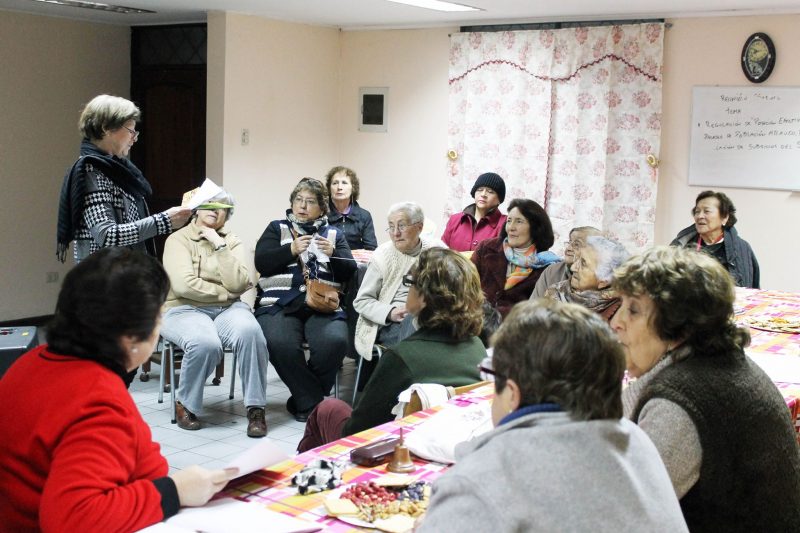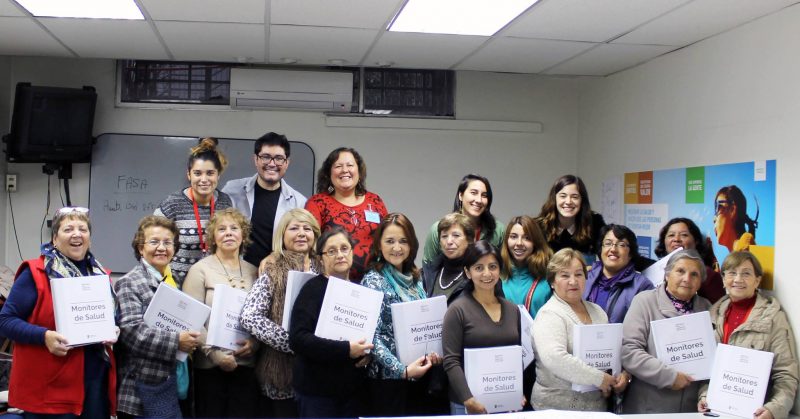Community health leaders: the user is the expert
Posted on December 8, 2016Colabora Salud is a social enterprise that we built with one sociologist, one nurse and three designers. We aims to collaboratively improve the public health system in Chile through consulting and project management, applying user-centered design strategies in every project.
We associated with Laboratorio Chile (Chile Laboratories) and Fundación Chilena de Hipertensión (an NGO related to arterial hypertension) to create the School for Social Leaders project, that seeks to educate people about arterial hypertension using methodologies from Popular Education in Health and collaborative design. Our objective was to strengthen the notion of self-care health by raising awareness in different communities about the risks of arterial hypertension, with help from experienced and knowledgeable Community Leaders, who are members of Local Development Councils and other territorial or functional organizations.
The modality of the program involved four classes, where, through the delivery of pedagogical tools in co-creative workshops, the development of activities and the elaboration of graphic media, we aimed to transfer the themes of promotion and prevention of arterial hypertension and its risk factors, and provide the tools for the Social Leaders to deliver the knowledge, using information validated by the NGO and the strong social ties between the Leaders and their communities.
The classes were divided as follows:
- Health education: social determinants, health in all policies, the Chilean health model, prevention and promotion, social participation in health.
- Arterial Hypertension: what it is, risk factors.
- Role of the Social Leader.
- How to be a Instructor.
For them to graduate from our School, after the four classes, they had to perform three Incidence Activities on their communities, which were designed by them using the knowledge they received from the School, adapted to the profile of their community. We were invited as spectators to their activities.

This was our pilot for the project. We worked together with designers, sociologists and a nurse. There were many challenges in its execution, specially in coordinating different disciplines and actors involved in the project.
From the beginning, we needed to ask ourselves as a team: how does design thinking address issues when designing a system? This system being understood as the new space of information and knowledge exchange between the providers of the information (NGO), the receivers of it (Social Leaders and their communities), the investors (Laboratorio Chile) and us, the executors (Colabora Salud). How do we convey the languages of the different sub-systems we were working with, find common ground, and understand their expectations?
To tackle this from the perspective of the Social Leaders, we conducted two surveys with them as participants, one at the beginning of the School, and one at the end of the process. We wanted to know how they perceived the information and knowledge we were giving them so we could improve our system for future instances of the School for Social Leaders. This was our way to have feedback from the inputs we were giving into the system of the School, see if our objectives were being met.
Even though each one of us had their own experience conducting courses or group activities, it was the first time that we, as Colabora Salud, had to demonstrate the methodologies and tools we were using (collaborative design, design thinking, popular education) were the right ones for the outcome we were seeking. We recognize the uncertainty of all the variables involved in the process, from the attendance of the Social Leaders (make sure they were going to attend each class) to the communication with Laboratorio Chile, who were the ones providing the space, materials and food for the classes. Everything mattered, every detail was important to provide a good experience for the School. At this point is important to know how to manage uncertainty, and be able to react if the conditions you were expecting don’t happen as you hoped.
The success of it was the bottom-up approach we give as a baseline to the project. The Social Leaders were the experts in knowing how to organize their communities, how to approach to them with a concept such as arterial hypertension, how to translate to their communities in their own language the information we were giving to them, and how to design the Incidence Activities so they could be understandable to everyone. The whole process was guided for them to create and execute the Incidence Activity, and that was the experience that validated the whole project and it’s methodologies, understanding that they were the specialist in that field.

In a way, we were tackling one aspect of the wicked public health care system, where there could be more than one opportunity to improve citizen education regarding to health issues (or many others too).
From there, we know better how to improve our School from the continuous feedback we received from the Social Leaders, which didn’t end after the closing ceremony. We kept in touch with them, this experience create a bond beyond what we thought possible. From this, we had the insight that they could be the next generation of instructors of the School for other Social Leaders, their motivation as innate leaders can be channel in this space. This initiative could scale in multiple ways, with the potential for many other themes to be discussed in, or even beyond, health care. That’s what we aim for as Colabora Salud – that’s how we demonstrate that collaborative design methodologies can help improve a massive system, such as public health care.